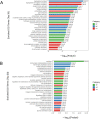Identification of key genes in chronic intermittent hypoxia-induced lung cancer progression based on transcriptome sequencing
- PMID: 38183079
- PMCID: PMC10770984
- DOI: 10.1186/s12885-023-11785-3
Identification of key genes in chronic intermittent hypoxia-induced lung cancer progression based on transcriptome sequencing
Abstract
Background: Obstructive sleep apnea (OSA) is associated with increased risk of lung cancer mortality. Nevertheless, little is known about the underlying molecular mechanisms. This research aimed to investigate differentially expressed genes (DEGs) and explore their function in Lewis lung carcinoma (LLC)-bearing mice exposed to chronic intermittent hypoxia (CIH) by transcriptome sequencing.
Methods: Lung cancer tissues in LLC-bearing mice exposed to CIH or normoxia were subjected for transcriptome sequencing to examine DEGs. Gene Ontology and Kyoto Encyclopedia of Genes and Genomes pathway analyses were employed to explore the function of DEGs. To evaluate the prognostic value of DEGs, the Kaplan-Meier survival analysis in combination with Cox proportional hazard model were applied based on The Cancer Genome Atlas.
Results: A total of 388 genes with 207 up-regulated and 181 down-regulated genes were differentially expressed between the CIH and normoxia control groups. Bioinformatics analysis revealed that the DEGs were related to various signaling pathways such as chemokine signaling pathway, IL-17 signaling pathway, TGF-β signaling pathway, transcriptional misregulation in cancer, natural killer cell mediated cytotoxicity, PPAR signaling pathway. In addition, the DEGs including APOL1, ETFB, KLK8, PPP1R3G, PRL, SPTA1, PLA2G3, PCP4L1, NINJ2, MIR186, and KLRG1 were proven to be significantly correlated with poorer overall survival in lung adenocarcinoma.
Conclusions: CIH caused a significant change of gene expression profiling in LLC-bearing mice. The DEGs were found to be involved in various physiological and pathological processes and correlated with poorer prognosis in lung cancer.
Keywords: Chronic intermittent hypoxia; Lung cancer; Obstructive sleep apnea; RNA sequencing; Transcriptome.
© 2024. The Author(s).
Conflict of interest statement
The authors declare no competing interests.
Figures





Similar articles
-
Effect of chronic intermittent hypoxia on gene expression profiles of rat liver: a better understanding of OSA-related liver disease.Sleep Breath. 2020 Jun;24(2):761-770. doi: 10.1007/s11325-019-01987-0. Epub 2019 Dec 16. Sleep Breath. 2020. PMID: 31845084 Review.
-
Predictions of the dysregulated competing endogenous RNA signature involved in the progression of human lung adenocarcinoma.Cancer Biomark. 2020;29(3):399-416. doi: 10.3233/CBM-200133. Cancer Biomark. 2020. PMID: 32741804
-
Chronic intermittent hypoxia impaired collagen synthesis in mouse genioglossus via ROS accumulation: A transcriptomic analysis.Respir Physiol Neurobiol. 2023 Feb;308:103980. doi: 10.1016/j.resp.2022.103980. Epub 2022 Oct 20. Respir Physiol Neurobiol. 2023. PMID: 36273780
-
A Novel Hypoxia-Related Gene Signature with Strong Predicting Ability in Non-Small-Cell Lung Cancer Identified by Comprehensive Profiling.Int J Genomics. 2022 May 19;2022:8594658. doi: 10.1155/2022/8594658. eCollection 2022. Int J Genomics. 2022. PMID: 35634481 Free PMC article.
-
Identification of significant genes as prognostic markers and potential tumor suppressors in lung adenocarcinoma via bioinformatical analysis.BMC Cancer. 2021 May 26;21(1):616. doi: 10.1186/s12885-021-08308-3. BMC Cancer. 2021. PMID: 34039311 Free PMC article.
Cited by
-
Ferroptosis: principles and significance in health and disease.J Hematol Oncol. 2024 Jun 6;17(1):41. doi: 10.1186/s13045-024-01564-3. J Hematol Oncol. 2024. PMID: 38844964 Free PMC article. Review.
-
Exploring Aerobic Energy Metabolism in Breast Cancer: A Mutational Profile of Glycolysis and Oxidative Phosphorylation.Int J Mol Sci. 2024 Nov 23;25(23):12585. doi: 10.3390/ijms252312585. Int J Mol Sci. 2024. PMID: 39684297 Free PMC article.
-
Analysis of the interlink between glucose-6-phosphate dehydrogenase (G6PD) and lung cancer through multi-omics databases.Heliyon. 2024 Jul 30;10(15):e35158. doi: 10.1016/j.heliyon.2024.e35158. eCollection 2024 Aug 15. Heliyon. 2024. PMID: 39165939 Free PMC article.
-
Comprehensive pan-cancer analysis of PPP1R3G reveals its diagnostic, prognostic, and immunotherapeutic implications.Discov Oncol. 2025 Apr 15;16(1):530. doi: 10.1007/s12672-025-02361-1. Discov Oncol. 2025. PMID: 40232629 Free PMC article.
-
Identification and validation of hypoxia-associated genes positively correlated with HIF1A in pulmonary adenocarcinoma.Transl Cancer Res. 2025 May 30;14(5):3113-3132. doi: 10.21037/tcr-2024-2265. Epub 2025 May 27. Transl Cancer Res. 2025. PMID: 40530158 Free PMC article.
References
MeSH terms
Grants and funding
LinkOut - more resources
Full Text Sources
Medical
Miscellaneous

